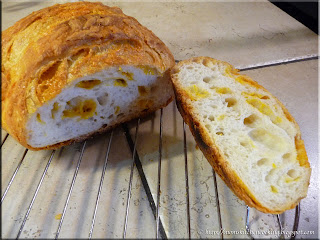Continuing with my bread experimenting, I made the third loaf of bread using the cold fermented dough (five minutes a day artisan bread). I am finding I really like this dough even though fermenting in the refrigerator does not save any time over using a regular knead dough and the container of dough takes up a fair amount of space in the refrigerator. It is no easier than the rough temperature fermented dough (no knead crusty dough). The only difference between using a fermented dough (eg. cold, room temperature, sourdough starter) is flavour.
First, I moved the oven rack up one notch to the middle position in my stove. This just gets the baking bread a bit further from the heat source, which in my case is at the bottom of the oven. Second, I reduced the preheat and baking temperature from 450°F to 425°F. All ovens are different so temperature adjustments are common. Regardless what temperature the recipe says to bake at, the temperature should be adjust to that which gives you the desired results in your oven. I have found that I have had to lower the baking temperature on many foods using the natural gas oven which seems to give the same results as my former electric oven but at a lower temperature. Finally, I reduced the baking temperature to 45 minutes (covered) and 5 minutes (uncovered) for a total bake time of 50 minutes rather than 65 minutes. This was a smaller loaf of bread that would bake quicker anyway requiring a reduction in baking time but the initial decision to reduce the temperature was based on improving the outcome of the crust.
A lot of sites and videos showing the results of the Dutch oven baked crusty breads show a very dark crust. I don't know if this is intentional, lighting or not realizing that the temperature can be adjusted. The problems with too dark of a crust is it can give a burnt flavour to the bread. We prefer a golden crust and in this case the goal is a golden crust that is crispy and chewy. I used a cup of shredded cheddar cheese and pressed it into the crust the same way I did for the cheesy garlic onion bread but this time worked it into the dough using lesser amounts of cheese at a time. I let the boule rest for 2½, slashed the top, then baked according to my adjustments. The crust came out exactly as I wanted without the bottom crust being over cooked. The crust crackled as it cooled, the tell tale sign of a good crispy crust. The colour was a perfect golden brown. My husband declared this loaf a keeper! It definitely was an outstanding loaf of bread with excellent texture and flavour. It was gone by lunchtime the following day with a request for another loaf.







0 food lovers commented:
Post a Comment